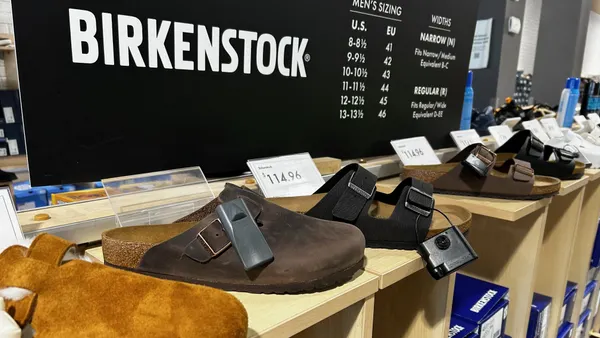Mobile is no doubt the “it” word in a retail industry that has been breathlessly adapting to consumers increasingly tied to their smartphones.
Still, despite the hype that accompanies the latest mobile widget, the cumulative impact of a new retail or shopping app here and there hasn’t yet budged m-commerce to meaningful new heights. M-commerce was predicted to account for a mere 1.6% of total U.S. retail sales in 2015 earlier this year, according to eMarketer.
But a funny thing happened on the way to holiday 2015. Facebook announced it’s testing an in-app, dedicated shopping section where users can discover and purchase products, as well as “Canvas,” immersive ads that double as shoppable content within the social network. The move could lead to the site’s emergence as a shopping portal for an infinite number of retailers, as so many people are already on the social network.
This is accompanied by a recent slew of “buy” buttons that enable shoppers to purchase directly from Twitter, Pinterest, and Google, as well as larger screens and mobile-optimized sites with easier checkout that make buying on smartphones, a big barrier to purchases, easier, “and by extension, more common,” according to eMarketer’s Holiday e-Commerce Preview report.
This holiday season will be a key indicator of whether or not m-commerce is headed for the big shopping leagues — so retailers better be ready. Retail Dive spoke to industry experts, who shared some of the best retail practices to capitalize on mobile commerce this holiday, and ways to skirt the pitfalls.
Make sure sales associates are just a helpful as mobile smartphones
The ubiquity of mobile devices means shoppers are using their smartphones and tablets as personal shopping assistants to research sales, products, and reviews before and during their time in stores, Lokesh Ohri, senior manager of Deloitte’s digital retail practice, told Retail Dive.
“With 82% of shoppers planning to do research online before making a purchase, retailers should understand that consumers are well-informed and expect seamless in-store purchasing experiences," Ohri said. "Although they are willing to complete the sale cycle in stores, they still want sales associates to be knowledgeable about products and to inform them of discounts.”
However, according to a Deloitte survey, 61% of shoppers believe they’re plugged in to information than store associates.
“Therefore, it is essential that retailers spend just as much time training and preparing associates for the holiday rush, proving that sales associates are just as helpful as mobile device,” he said.
Stop selling to the customer: Engage them
A number of Kurt Salmon's, a global consulting firm, clients approach mobile as a critical channel for their holiday marketing campaign, Andrew Wong a partner with Kurt Salmon Digital, told Retail Dive.
“With well over 70% of emails opened on mobile devices and mobile traffic continuing to increase, certainly mobile is a critical piece of the holiday marketing plan. But, at the same time, m-commerce has relatively low conversion rates and overall revenues compared to other channels,” he said.
“Therefore, we don’t believe leveraging mobile purely as a marketing channel and funnel to e-commerce for the holidays is a mobile strategy.
Instead, retailers should view their mobile holiday efforts “as part of a holistic digital strategy to drive continuous engagement throughout the season and into next year in stores, online, on social media, etc,” Wong said. "A great example is the success some retailers have had launching coupon and gift and wish list mobile capabilities for the holidays, which ultimately continue to drive long-term engagement and purchasing.”
Interact with shoppers throughout the path to purchase with personalized offers
Mobile and online purchases are rising every year, but there are also more opportunities to engage with consumers face-to-face during their digital shopping journey. For one, 43% of shoppers are planning to buy online and pick up in-store, and 35% plan to pick up additional items on the same trip, Deloitte’s Ohri said.
“Retailers should consider customers’ in-store experiences when developing mobile holiday strategies just as much as they plan to engage with them online," Ohri continued. "Perhaps they recommend related products to accompany the item a customer is picking up, or send them specific notifications prior to their store visit.”
The Deloitte survey also revealed that 3 in 5 shoppers (60%) would search on retailer websites for gift recommendations. “This gives retailers additional opportunity to influence consumers who are looking to them for ideas,” she said.
“Additionally, recommendations go hand in hand with personalization. It’s not just about recommending a product for another product – it’s about considering the context as well. For example, if a lady purchases a tie, it’s fair to assume it’s a gift. Retailers [should] then recommend other products that would go well with the tie to either complement the gift or add to the overall experience.”
Create local store websites with inventory listings
More and more, consumers are shopping from their smartphones in the store aisles. “You’re seeing big boosts from m-commerce during Black Friday weekend,” Yory Wurmser, an analyst with eMarketer, told Retail Dive.
Consumers are using their phones in stores to add products to their virtual shopping carts, often motivated by “line avoidance,” he said.
To capitalize on this growing habit and make it easier for consumers to buy, retailers would be wise to offer granular data on the inventory available in a particular store, or nearby store, he said.
The idea is to create customized websites, “so the shopper is getting local concrete data [on product availability].” These local inventory sites could also help drive foot traffic into stores during the holiday, and sales. Let’s say a shopper is in the mall on Black Friday, they search for a product and see Macy’s doesn’t have it, but Bloomingdale’s its sister chain, does. “They’ll go into Bloomingdales to pick it up, and [theoretically] buy something else when they’re there,” Wurmser said.
Maximize dollar value of customer touch points instead of chasing traffic
During the make-or-break holiday selling season, retailers often look to maximize the number of touch points they make with shoppers to “break through the noise,” Kurt Salmon’s Wong said.
But retailers must be careful not to squander access to consumers, and be judicious and strategic in how and when to reach out.
“With a direct channel to customers anytime anywhere, the mobile channel is very personal, highly valuable and hard to re-establish if lost. Therefore, we approach mobile engagement with a different level of sensitivity and goals, he said.
“Often clients come at it from an approach where they want to just have the most number of touch points as possible and assume driving the maximum amount of traffic is the primary focus and let conversion fall where it may,” he said.
Kurt Salmon advises retailers to maximize the overall dollar value of each touch point and then factor those findings into an engagement strategy, number of touch points, and an “understanding of where we have diminishing returns so we don’t over message the customer to the detriment of their relationship with the brand,” Wong said.
One example: A retail client’s holiday campaign that issued daily December messages. “They over engaged their customers to the point that we saw a peak engagement and conversion rather early in the month, and then a steady drop off all the way to holiday,” he said.
By contrast, another retail client opted for a deliberate and measured holiday social engagement strategy that focused on “making each touch point special,” Wong said. The result: “We saw much steadier engagement with customers through the whole course of the campaign.”





















